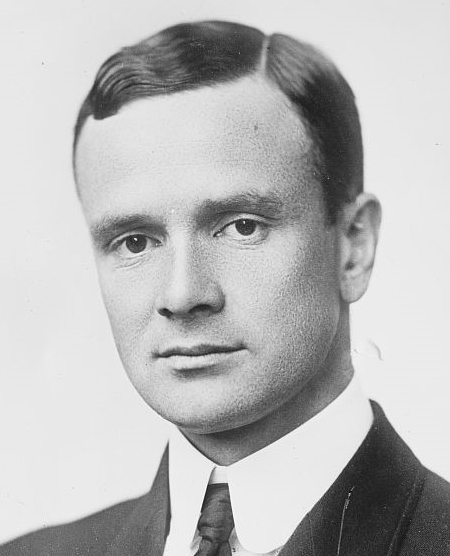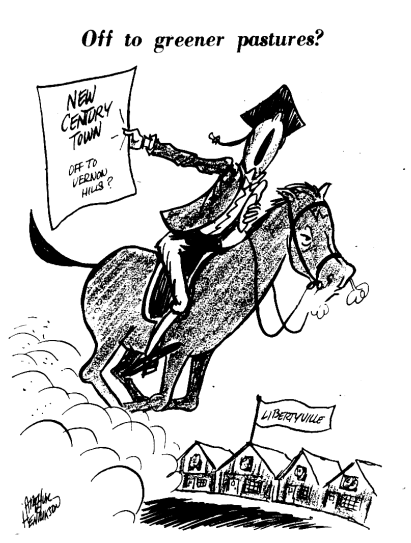Anyone who has driven by the Vernon Hills Hawthorn Mall recently can see big changes are in store (no pun intended). But how did it all start? From millionaire farmers to small scrappy towns, there’s a surprisingly rich history prior to the arrival of the mall in early 1970’s.
During the late 19th and early 20th century a number of Chicago businessmen including George F. Bissell and Samuel Insull took up the “hobby” of farming. Buying large tracts of land, they built lavish mansions as a refuge away from the city while the farming was mostly done by their employees. In 1906 they gained a new neighbor in the person of Joseph Medill Patterson. Born into a wealthy family on January 6, 1871, Patterson was the grandson of Joseph Medill, co-founder of the Chicago Tribune and mayor of Chicago from 1872 – 1873 [1]. Despite his affluent upbringing, Patterson was critical of the disparities he saw around him. After serving in the Illinois House of Representatives from 1903-04, he worked for the Tribune before abruptly resigning in 1906 after an argument over his socialist views. Retreating to Libertyville, he hired Chicago architect Howard Van Doren Shaw to build a red brick Federal-Style mansion, located on Townline Rd. and Milwaukee Ave., which became known as Westwood [2].
Using his country estate as a writer’s retreat, Patterson penned novels critical of the rich including A Little Brother of the Rich (1908) and The Fourth Estate (1909). Patterson moved to New York in 1919 to found the New York Daily News, leaving the running of Westwood to his wife Alice and their daughters Elinor, Alicia, and Josephine. Patterson and his wife separated in 1928 and divorced in 1938. Their daughter Josephine continued living on the property in a separate house. She was known for hosting Halloween parties for local children and taking them ice skating on the property’s lake [3]. Following her father’s passing in 1946, Josephine sold the property to John Cuneo Sr. (who had previously purchased the next door Hawthorn Farm from the estate of Samuel Insull). In 1951 Cuneo rented the mansion to Hewitt Associates to use as their headquarters.


The 1950’s and 60’s saw much of the land that had once belonged to farmers broken up and bought by various real estate developers. On January 4, 1957, the Lake County Board of Supervisors sold 120 acres of land just south of Route 45 and Butterfield Road for $60,000 ($596,326.09 today) to Barney Loeb and Quinn Hogan, the joint owners of L & H Builders Inc. of Mundelein [4]. Later that year on August 31, 1957, with twenty homes already built, the forty-one residents of the village (which at the time was using the name Forest Hills) filled a petition to incorporate with the Lake County Clerk’s office [5]. However, because so many residents worked for L & H, the Lake County State’s Attorney’s Office became concerned that the company planned to use the village to avoid taxes. On July 15, 1958, voters approved the incorporation of the village of Vernon Hills 45 to 1 [6]. In late 1958 the Lake County State’s Attorney filed a complaint, accusing the village trustees of holding “pretended offices” [7]. The case eventually made its way to the Illinois Supreme Court, who ruled on September 29, 1960, that there was no evidence that L & H controlled Vernon Hills [8].


The population of Vernon Hills grew from 123 in 1960 to 1,050 in 1970 [9]. Despite this, Vernon Hills was still little more than a handful of homes, the Tally Ho Country Club, and a part-time police force comprised of village trustees who patrolled streets lit by a single street lamp. That all changed in August 1970 when Urban Investment & Development Co. approached the village board of Libertyville with a proposal. The company wanted Libertyville to annex 591 acres of land north of Route 60, at the time part of John Cuneo’s landholdings, where the company would build a new subdivision. New Century Town (NCT), costing $250 million ($1,782,145,618 today) would add around 15,000-18,000 residents to the area, as well as a 1.3 million-square-foot shopping center, Hawthorn Center, costing $45 million ($303,963,333 today) [10].
While then-Libertyville mayor Charles Brown and a number of trustees were in favor of the proposal, residents quickly became split on the issue. Packed meetings to discuss the annexation were held throughout that winter, with attendees voicing concerns ranging from the increase in population to having to pay for sewer and water improvements. A group called the Citizens Right to Vote Committee published ads in the Independent Register opposing the annexation and circulated a petition demanding a referendum [11]. Despite the fact that the referendum would not prevent the NCT from being built, and possibly because the company had indicated that they would withdraw their offer if the annexation was put to a referendum, the Citizens Right to Vote committee pressed ahead with their plans to force a vote on the issue [12].


As it had promised, on February 4, 1971 Urban Investment & Development Co. pulled its offer, a move that Libertyville’s lawyer Willis Overholser said was “the worst disaster that ever happened in Libertyville.” Even the co-chair of the Citizens Right to Vote Committee, when contacted about the NCT pullout commented that “I can’t say that I’m elated” [13]. That same day John Sullivan, then village president of Vernon Hills, announced that Urban Investment had submitted a proposed pre-annexation agreement to the village board and that their lawyers were already looking over the paperwork. Jumping on the opportunity, the Vernon Hills Village Board voted in favor of the proposal, annexing 591 acres of land north of Route 60 on April 6, 1971. Construction on the mall and New Century Town began later that year [14]. That fall, Hewitt Associates, having outgrown Westwood, had moved their headquarters to Deerfield, clearing the way for the demolition of the mansion.

Hawthorn Center had its grand opening on September 10, 1973. The two story mall was designed to “simulate shopping streets of Europe,” with brick-paved halls and old fashioned street lights [15]. Skylights provided the interior with glare-free natural light to simulate an open mall center. At its opening the mall boasted 140 stores including Marshall Field, Sears, Montgomery Ward and Lord & Taylor along with fifteen specialty shops.
The arrival of the mall and New Century Town marked a turning point for Vernon Hills. By 1980 the population of Vernon Hills had grown to 9,827. The mall provided 2,000-3,000 jobs and raised more than $1 million in sales tax annually [16]. During this time, despite numerous requests to establish an arcade at mall, Hawthorn Center management turned them all down. “We have very high standards for this mall,” said mall spokeswoman Helen DeWitt. “While young people are welcome here, we don’t encourage a hangout atmosphere” [17]. The mall did eventually open a food court in 1982 and in 1989 finally bowed to pressure and added Aladdin’s Castle, an arcade with coin-operated games, pizza, and various prizes that kids could win. Drawing shoppers from across Lake County, the mall continued to grow. A JCPenney was added in 1997 as the mall’s fourth anchor store.


The Hawthorn Mall has gone through many changes over its lifetime and if the construction going on right now is any indication, will continue to do so. If you’d like to learn more about the history of the mall, Vernon Hills, or New Century Town, come in and view the Local History Clippings files in the lower level of the Cook Park library. You can follow recent developments using the America’s News database available through the Research page. The database offers searchable, full-text content of the Libertyville Review, Vernon Hills Review, and Daily Herald back into the 1990s. Additionally, if you’d like to learn more about the gentlemen farmers of Lake County, the Libertyville-Mundelein Historical Society has a great video about them.
The following sources used in this post can be found in the Cook Memorial Public Library District collection.
Sources
- History Matters: Gentleman Farmers of Libertyville and Lake Forest. Libertyville-Mundelein Historical Society, 2020. https://www.youtube.com/watch?v=iZpHb9OVngU&t=2455s.
- “Socialist Joseph Medill Patterson Buys Lake Country Farms.” Lake County Independent and Waukegan Weekly Sun. August 24, 1906, p. 2. https://vitacollections.ca/cmpldnewsindex/3169880/page/2.
- History Matters. 2020.
- Zawislak, Mick. “The Origin of Vernon Hills.” Daily Herald, July 18, 2008. https://bit.ly/3L4spko.
- “Vernon Hills Area Seeks Incorporation.” Independent-Register. September 12, 1957.
- Spencer, Mark. “From Pastures to Commerce – Shopping Malls and Subdivisions Shape the Landscape of Vernon – Hills.” Daily Herald. September 21, 1999. https://bit.ly/3L4spko.
- People ex Rel. Moran v. Teolis, 20 Ill. 2d 95, 169 N.E.2d 232 (Ill. 1960), Google Scholar (Supreme Court of Illinois 1960). https://bit.ly/3HpGTJ5.
- “Supreme Court Rules Vernon Hills Is Town.” Independent-Register. October 6, 1960.
- “Population Trends by Location, 1950-2000.” Lake County, Illinois, December 8, 2015. https://lakecountyil.gov/DocumentCenter.
- Gehrig, Jan. “New City Unveiled.” Independent-Register. July 30, 1970.
- “Petitioners Seek Vote on New Century Town.” Independent-Register. December 10, 1970.
- Boscarine, Leonard. “Ok NCT Referendum.” Independent-Register. January 28, 1971.
- Boscarine, Leonard. “Attorney — NCT Loss Our Worst Disaster.” Independent-Register. February 4, 1971.
- Gehrig, Jan. “Vernon Hills annexes NCT” Independent-Register. April 8, 1971.
- “Hawthron Center Goes European.” Independent-Register. December 14, 1972.
- Mincer, Jilian. “When Shopping Mall Arrived, so Did Vernon Hills.” Chicago Tribune, December 21, 1983.
- Skaugen, Cindy. “Mall Puts Grace Ahead of Glitz.” Chicago Tribune, October 21, 1983.
- Unknown. West Wing of Hawthorn Mall (1970s). June 17, 2021. Photograph. Wikimedia Commons. Wikimedia Foundation. https://en.wikipedia.org/wiki/Hawthorn_Mall#/media/File:West_wing_of_Hawthorn_Mall_(1970s).jpg.
- Unknown. Former Sears at Hawthorn Mall (Now demolished) (1970s). June 17, 2021. Photograph. Wikimedia Commons. Wikimedia Foundation. https://en.wikipedia.org/wiki/Hawthorn_Mall#/media/File:Former_Sears_at_Hawthorn_Mall_(Now_demolished)_(1970s).jpg.
Categories: Local History
Tags: Local History
